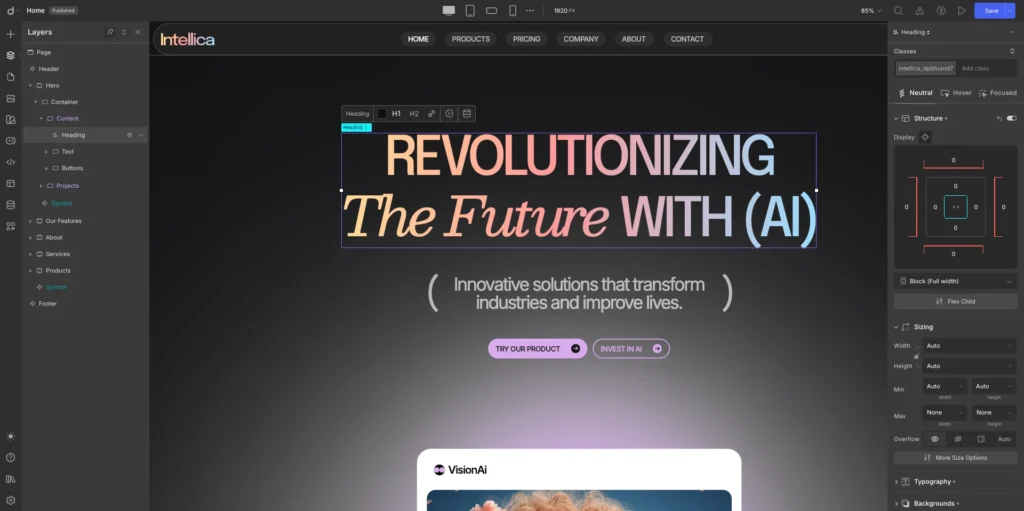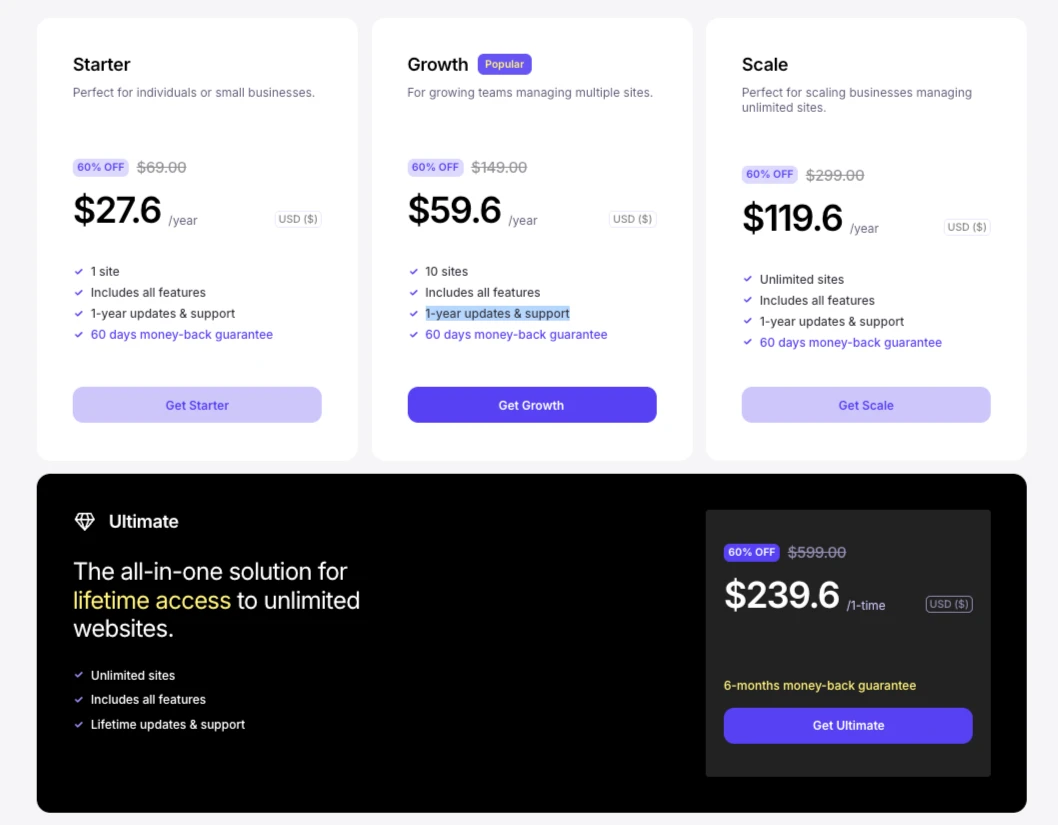Droip Review 2025: Is This New Page Builder Worth Switching From Elementor?
👉 Elementor is the big dog — super popular, tons of templates, massive community. But it can feel… heavy. Clunky. Sometimes slow. And then there’s the constant upsells for Pro features and add-ons.
If you’re like me, you might have wondered: Is there a lighter, modern, more flexible alternative?
Recently, I came across Droip — a new player in the page builder space. I installed it on my local server and spent a week playing with it.
Here’s my deep-dive, no-fluff, real review — plus how it stacks up to Elementor.
What Exactly is Droip?
Droip is a visual, no-code page builder for WordPress. It’s designed for people who want to build custom, modern-looking websites without coding — but still want flexibility beyond basic drag-and-drop blocks. In short, Droip tries to fix some pain points that older builders like Elementor haven’t solved well:
- Clean code output (so your website isn’t bloated)
- Modern layout controls (think CSS Grid, Flexbox, absolute positioning)
- More control for designers who want pixel-perfect sites
- Live editing — what you see is truly what you get
🚀 Who Should Care About Droip?

- 🧑💻 Freelance developers or web agency owner who’s tired of cookie-cutter Elementor websites
- 👨🎨 Web Designer who wants more layout freedom without coding from the scratch
- 🧩 DIY website owners who wants to create website without learning CSS and complex javascript code
…Droip might be worth a test drive.
Pros of Elementor:
- Massive Popularity & Community: There’s no denying it — Elementor has a huge following. That means endless tutorials, active forums, and countless third-party add-ons. If you ever get stuck, chances are someone else has already faced the same issue — and found a fix for it.
- Rich Feature Set (especially Elementor Pro): Elementor, particularly with its Pro version, offers a comprehensive suite of tools(Widgets) for building almost anything:
-
Drag-and-drop visual editor: Intuitive for beginners and efficient for experienced users.
-
Extensive Widget Library: A wide array of elements for text, images, forms, sliders, testimonials, and much more.
-
Theme Builder: Customize headers, footers, post layouts, archive pages, and even WooCommerce product pages.
-
Popup Builder: Create various types of popups for lead generation and engagement.
-
Dynamic Content: Integrate with custom fields and other WordPress plugins.
-
AI capabilities: Elementor AI assists with content and code generation.
-
Huge Template Selection: Ready-to-use full-page templates and blocks.
Cons of Elementor
- Bloat and Performance Impact: This is a recurring criticism. Elementor can generate a lot of extra HTML and CSS, leading to slower page load times and increased HTTP requests. While optimizations can help, it's often an uphill battle.
- "Constant Upsells for Pro features and add-ons": As you mentioned, many essential features are locked behind the Pro paywall, and the ecosystem of third-party add-ons, while extending functionality, can quickly lead to plugin sprawl, maintenance headaches, and additional costs.
- Complexity: For its power, Elementor can feel overwhelming for new users due to the sheer number of options and settings. The interface, while visual, can be cluttered.
- Dependency on external plugins: While Elementor has a lot built-in, complex functionalities often still require additional plugins, leading to potential compatibility issues and increased maintenance.
🧩 Key Features — What Makes Droip Different?
Let’s break down what Droip does — and where it tries to stand out.
Modern Visual Editor
Droip’s editor is clean. If you’ve used Elementor, you’ll feel at home — drag sections, drop elements, tweak styles visually. But Droip pushes it further:
- You can use Flexbox and CSS Grid directly — so layouts feel less rigid.
- Want overlapping elements? Absolute positioning is built-in.
- Hover states and animations are easy — no add-on required.
Component System
One thing I really liked: Reusable components. You can design a block — say, a testimonial card or CTA section — and reuse it across pages. Update the master, and it updates everywhere — no more hunting down duplicate b ocks. Elementor has something similar with Global Widgets, but Droip’s approach feels simpler.
Clean Code Output
Heavy builders often inject tons of unnecessary divs and inline CSS. I inspected Droip’s output — it’s not “perfectly pure”, but it’s cleaner than some older builders. Less bloat usually means better page speed.
Animations & Micro-Interactions
Subtle interactions are the trend these days — buttons that wiggle, sections that fade in, elements that slide as you scroll. Droip lets you do these natively.In Elementor, you usually need extra plugins for fancy scroll effects.
Live Preview
You see changes as you build — no flipping between “Edit with Elementor” and the frontend preview. Small thing, but it saves time.
Live Preview
You see changes as you build — no flipping between “Edit with Elementor” and the frontend preview. Small thing, but it saves time.
Built-In Dynamic Content Manager
No need for ACF or Pods — Droip has native custom content types and custom fields. Design dynamic templates visually, manage dynamic SEO, and build more complex sites without stacking plugins.
Built-In Dynamic Content Manager
No need for ACF or Pods — Droip has native custom content types and custom fields. Design dynamic templates visually, manage dynamic SEO, and build more complex sites without stacking plugins.
Global Styling with Classes & Variables
True global design system:
- Global Classes: Update a button style once — it changes site-wide.
- Variables: Manage your color palette, fonts, spacing, and even theme modes (light/dark) consistently.
Accessibility & Best Practices by Default
Droip encourages semantic HTML, alt text, ARIA labels, and checks contrast to help you build accessible sites without hunting for extra tools.
AI Generator
Need a quick starting point? Generate layouts or sections in seconds.
Figma Integration
Push your Figma designs straight into Droip — convert designs to live, responsive pages with fewer manual tweaks.
All-in-One Approach
Fewer third-party dependencies = less bloat, fewer updates to juggle, and lower risk of conflicts or plugin overload.
Transparent Pricing
Early feedback suggests Droip’s pricing is straightforward — no constant upsells for basic features.
🔬 My Actual Test — What I Built
- A simple landing page with hero, features, testimonials, CTA
- Tested advanced layouts (overlapping text on images, complex grids)
- Added scroll animations
My local site loaded faster than a similar page in Elementor with the same content. That’s promising.

👍👎 Droip Pros and Cons (After a Weekend of Testing)
What I Loved
- Intuitive for Elementor users — no learning curve shock
- Clean, modern UI
- More layout flexibility (overlaps, grids, flex)
- More layout flexibility (overlaps, grids, flex)
- Reusable components save time
- Faster page load (in my test)
- Scroll animations built-in
What Bugged Me
- Fewer pre-made templates (Elementor has thousands)
- Smaller community — less documentation and tutorials for weird use cases
- Still young — I ran into minor bugs in the UI (nothing critical, but worth noting)
- No huge third-party ecosystem yet (addons, widgets, extensions)
💰 Droip Pricing — How Much Does It Cost?
Right now, Droip has a free version with core features — enough for simple pages. Paid plans unlock advanced widgets, premium templates, and priority support.
Compared to Elementor Pro, Droip’s pricing is lower for now — but it’ll probably go up as they add more stuff.

⚔️ Droip vs Elementor — The Big Question
So should you dump Elementor for Droip? Here’s my take:
| Droip | Elementor | |
|---|---|---|
| Ease of use | Easy, familiar | Easy, super polished |
| Layout freedom | More modern (grid, flex, absolute) | Good, but more rigid |
| Templates & blocks | Limited for now | Massive library |
| Performance | Lighter output | Can get bloated |
| Community & support | Small, growing | Huge |
| Third-party add-ons | Few | Tons |
| Pricing | Cheaper now | Well-known, flexible plans |
🎯 Who Should Pick Which?
Stick with Elementor if:
- You need 1,000+ pre-made templates
- You want huge community support & tutorials for everything
- You’re deep into third-party Elementor add-ons
Try Droip if:
- You want lighter, modern code
- You like playing with design freedom (overlapping, absolute, grid)
- You want a clean slate — less bloat, more speed
🧑💻 Practical Use Cases
Who might love Droip?
- You need 1,000+ pre-made templates
- Agencies who want lighter sites to boost Core Web Vitals.
- DIY business owners who don’t want to mess with a bloated builder.
❓ FAQs About Droip
Is Droip stable enough for production sites?
For simple sites, sure — but test it well before going live, especially for client work. It’s still new.
Can I migrate from Elementor to Droip?
Not directly — you’d rebuild pages manually. They’re different builders.
Does Droip work with any theme?
Works best with blank or minimal themes (like Hello Elementor). Avoid bloated multi-purpose themes.
Can I use Droip with other plugins?
Yes — standard WP plugins work fine. Just test for conflicts, especially with other builders.
Is Droip easy for beginners?
If you know Elementor basics, you’ll pick it up in an hour. Total newbies might need to watch a quick tutorial.
Is Droip good for speed?
So far, yes. My pages loaded faster than my bloated Elementor test pages.
Can I use Droip for client sites?
Absolutely — just test it well since it’s newer than Elementor.
🏁 Final Verdict — Should You Try Droip?
👋 Your Turn
👉 Have you tried Droip? What did you build with it?
Drop your thoughts in the comments — I’d love to see what you think!
PS: Want me to do a detailed tutorial next? Let me know — I might drop a full step-by-step Droip landing page build soon!

